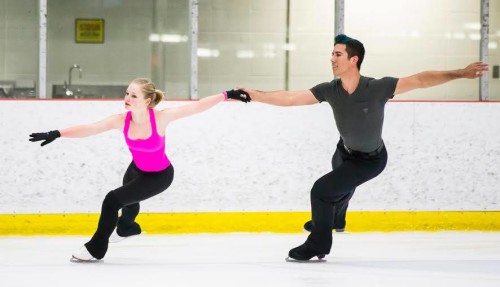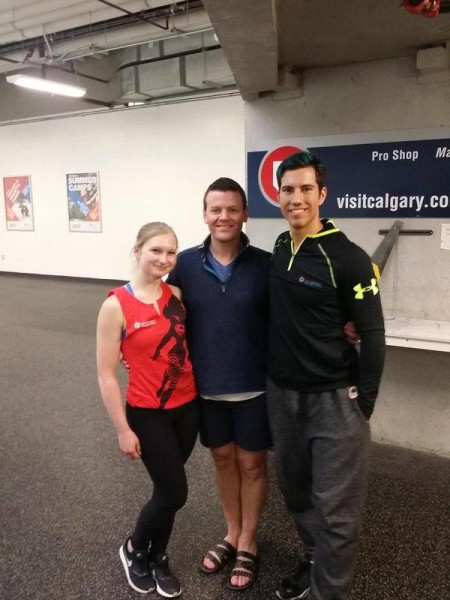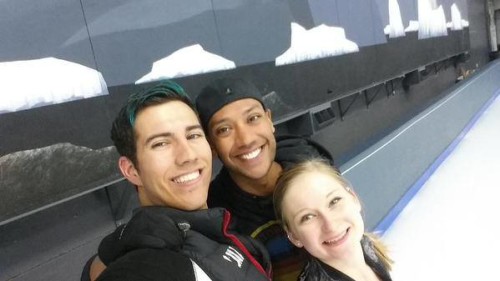by Jacquelyn Thayer
After competing at the 2014 Olympics and World Championships, four-time Canadian pairs bronze medalist Rudi Swiegers parted ways with Paige Lawrence, his partner of nine years, and took a step back from the realm of competitive skating, making some time for daily life.
“I really took my year off for myself,” he said. “I was able to go visit family in South Africa that I haven’t seen in over a decade. I was able to slow down and live at a ‘normal person’s pace.’ I got a job back in Virden and kind of enjoyed the fruits and labors of not being a focus-driven athlete on a day to day basis.”
Following the end of her own partnership in 2013, Hayleigh Bell, Canadian junior pairs champion that year with Alistair Sylvester, spent the ensuing two seasons out of major competition—with mysterious leg pain in the summer of 2014 raising concerns.
“At first, because of where I complained of pain, they thought it was a stress fracture to my ankle,” she said. When tests and X-rays proved negative, one doctor considered the possibility of chronic compartment syndrome. “It was tested and confirmed in August,” she continued. “Surgery was the second week of September, in Toronto. In the beginning of October, I was back in Calgary and getting about an hour of physio every day as well as using the water treadmill for recovery. My leg wasn’t ready for the singles season so I couldn’t compete.”
Bell and Swiegers tried out in December 2014—meeting a self-imposed deadline for Swiegers, who committed to finding a partner by year’s end or retiring—before briefly parting ways for the holidays. Two weeks after her own return to the ice, Bell’s pain—and compartment syndrome—had also returned. Another surgery, this time involving removal of the fascia, came in March.
“I sometimes have problems with it, so I have to make sure that I take the appropriate steps to keep it from flaring up too badly,” she continued. “I haven’t had to change much in terms of the way I train or do things, but I have to make sure I stretch it out properly before and that it’s taken care of every night so that it’s okay for the next day of training.”
“Hayleigh is very proactive in her recovery to make sure that by the next day, she is good to go again,” added Swiegers.
Coming together as a new team, training in Calgary under three-time Canadian pairs medalists Anabelle Langlois and Cody Hay, has involved a series of adjustments for both.
“It’s completely different working with a new person compared to the old partner,” said Bell, who had done some work with Langlois and Hay at the Mariposa School of Skating in her previous partnership. “It’s about getting used to them as a person and their personality, and their style of training.”
For Swiegers, change came after a career largely spent training under Patricia Hole and Lyndon Johnston. “It’s taken some getting used to,” he said. “For the most part where it’s such a fantastic facility, the adjustment to the coaching staff has come easy because we have such a great team behind us. Everyone is so positive, and with that positive vibe the adjustment was smooth.”
Notably, both partners are clockwise jumpers, an asset given the relatively few pair skaters who are. And certain other developments have come smoothly. “I think the throws came really easily,” said Swiegers, with Bell agreeing. “I think just how our personalities match up has come really easily.”
In addition to Langlois and Hay, who coach the bulk of the pair’s on-ice focuses, support at the Canadian Sport Institute/WinSport includes Kelly Quipp on cardio and Chris Osmond as strength coach. Bell also works with Di Lefebvre, whose “Burlesquercise” classes present an additional opportunity to combine fitness and performance.
Program development, like much of the transition, has proven a comfortable process. Mark Pillay brought the idea for a rock-edged short to “November Rain” by Guns N’ Roses. “He had a great vision for us, and we were able to tie into his vision,” said Swiegers.
The free, to selections from the score of Howl’s Moving Castle, came with additional collaboration. “Hayleigh and I both decided on the music after listening to countless songs,” said Swiegers. Tyler Myles, who had previously worked with Bell and Sylvester, choreographed. “He was really able to pick up on the nuances that are us and it’s a very special program to us.”
After a late withdrawal from August’s Central Ontario (Thornhill) Summer Skate due to concussion for Swiegers, the pair finally made their competitive debut at October’s Autumn Classic International at Bell’s former training grounds in Barrie. Though the pair finished fifth in a slate of five, they achieved the World Championships technical minimum score in the free program and came just 0.67 shy in the short program; both scores easily passed the TES requirements for the Four Continents Championships.
“Autumn Classic was the first time for us to compete together,” said Bell. “It was about learning to compete with each other and learning to compete again after both having breaks, and it was good to just be out in front of a crowd again and getting the support from that.”
And while the pair made a later than hoped for start, a small global pairs field and Swiegers’ international standing as of 2013-14 helped the team pick up a Grand Prix assignment outright—one they’ll be tackling this week in Moscow at Rostelecom Cup.
“Being such a new team, our goals are just to be very positive and get as much feedback from the judges as possible,” said Swiegers. “We’re very excited to be out there and be able to enjoy the crowd together. Our biggest goal is to get the fans excited about us and excited in general about our skating.”
But amid the standard issues attached to developing as a pair, the team are also focused in on one that’s impacting many amateur athletes, particularly skaters—funding. As a new pair, Bell and Swiegers are currently not eligible for Skate Canada national team funding, generally predicated upon top five results at the prior season’s national championships, as well as other primary sources of organized funding in Canada, often based too on prior-season results for a team or one partner.
“We have no financial support, so it’s all coming out of pocket or us working or our family members,” said Bell. “It’s quite difficult to do on top of training. More and more athletes are realizing that they need help instead of going into so much debt throughout their careers.”
Bell works as an assistant at Calgary’s PC Cooking School. “I’ll do anything from helping out at adult cooking classes to kids’ birthdays and kids’ classes,” she said. “I get to interact with all types of people and different types of classes and a lot of cooking.” Swiegers primarily coaches, and is also involved with the You Can Play Project.
So given the limitations of funds and time, the duo took their cause to Pursu.it, a crowdfunding site dedicated exclusively to support for amateur athletes. And with the direct engagement a crowdfunding campaign can mean for fundraisers and donors—Bell and Swiegers are offering a variety of rewards for supporters, including personalized thanks by video or card, a workout mix CD and even a skating lesson—Swiegers notes its impact on the athlete/fan dynamic.
“I think it’s one of those things that can connect athletes to fans and vice versa on a personal one-on-one level,” he said. “A lot of fans and supporters would love to be able to help out their favorite athletes and this gives us a way to give back on a personal level.”
It is, in its way, another connection in this year of new bonds for Bell and Swiegers.
NOTE: Due to the costs and time involved in maintaining and further growing Two for the Ice as an outlet, we’ve recently launched a funding option through Patreon, with small suggested monthly donation rates. We appreciate any support!



